Defensive Specialists, part 3 - Robert Covington's seamless adaptation to Houston Rockets' Defensive Scheme
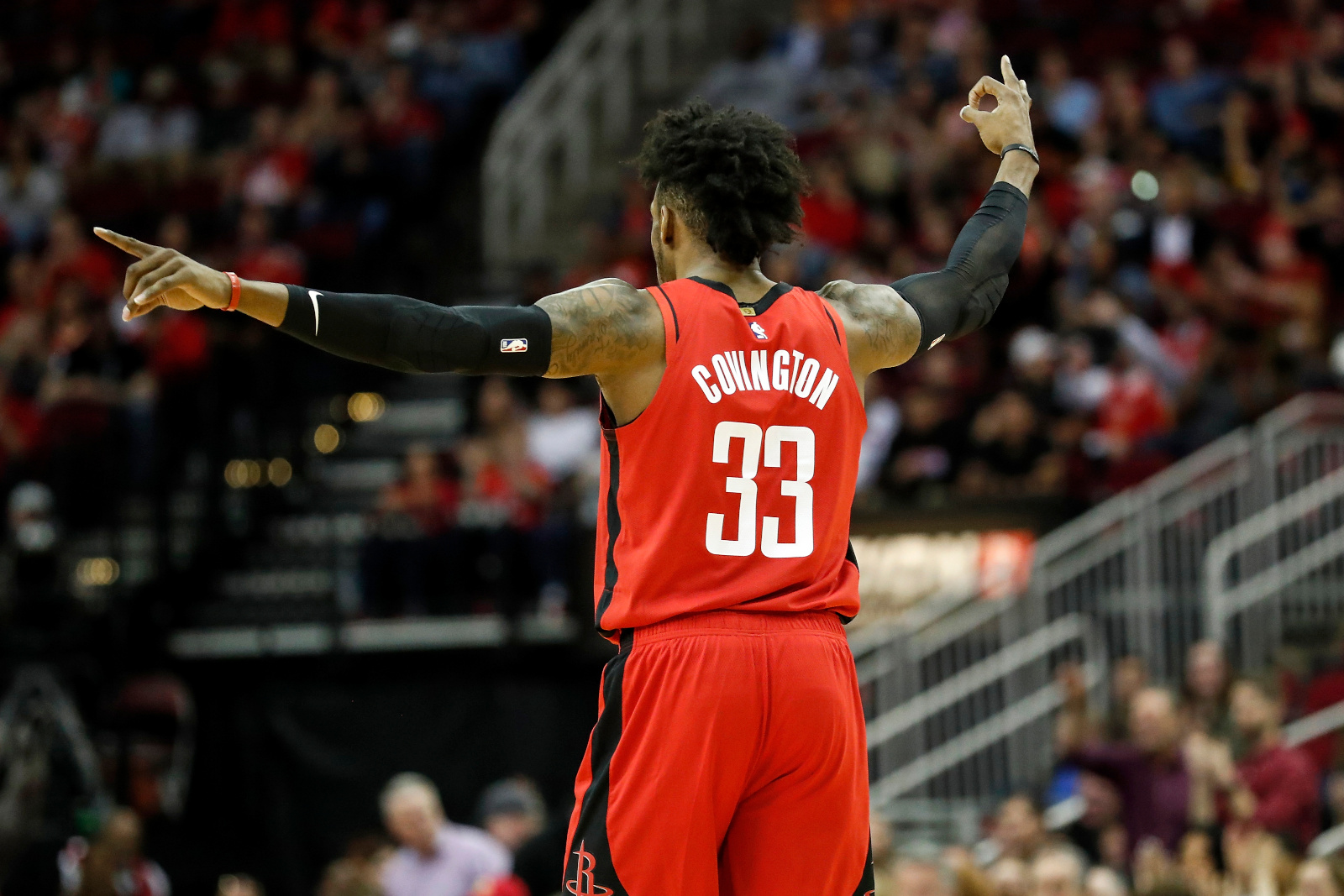
After Houston Rockets pulled off the deal for Robert Covington at this year’s trade deadline many wondered what are the Rockets doing and how will their team look, especially in the defense. Well, they are doing as good as before, maybe even better, and one of the biggest factors in their Defense has been Robert Covington.
But first, let’s go back to the beginning of the career of Robert Covington.
Early Days in the NBA
Covington went undrafted in the 2013 NBA draft, after which he played for Rockets in Summer League. They were pleased with him and signed him to an NBA contract. However, he spent most of his first NBA season in D-League (now G-League) playing for Rio Grande Valley Vipers.
He was named an All-Star that season and became MVP of the All-Star game, he continued with great performance through the rest of the season and won the Rookie of the Year award in D-League. Even then he displayed what he is best at, shooting and defending. Covington has averaged 23.2 PPG while shooting 37% for 3. Along with that, he averaged 9.2 rebounds and 2.4 steals and 1.4 blocks per game, proving already then that he is a complete defensive player.
Heart of the Process
At the end of 2013-14 season, Covington signed a 4-year contract with Philadelphia 76ers. Immediately in his first season, he surged to the starting lineup. He maintained a pretty similar role as he had while he was at college and in G-League, playing as a Small Forward. In my opinion, he represents the heart of the 76ers’ Process, an undrafted player who wasn’t given a chance in other NBA teams but thanks to his constant hard work and playing hard in the D-League he proved himself as a serviceable NBA player.
He earned respect through seasons as one of the prime 3 and D players in the NBA. He was the ideal fit for Sixers’ play style, as he could have spread the floor in the offense and cover anyone in the defense, taking on best opposing Guard or Forward. His defensive excellence was officially recognized in the 2017-18 season when he was named into the NBA’s All-Defensive First Team.
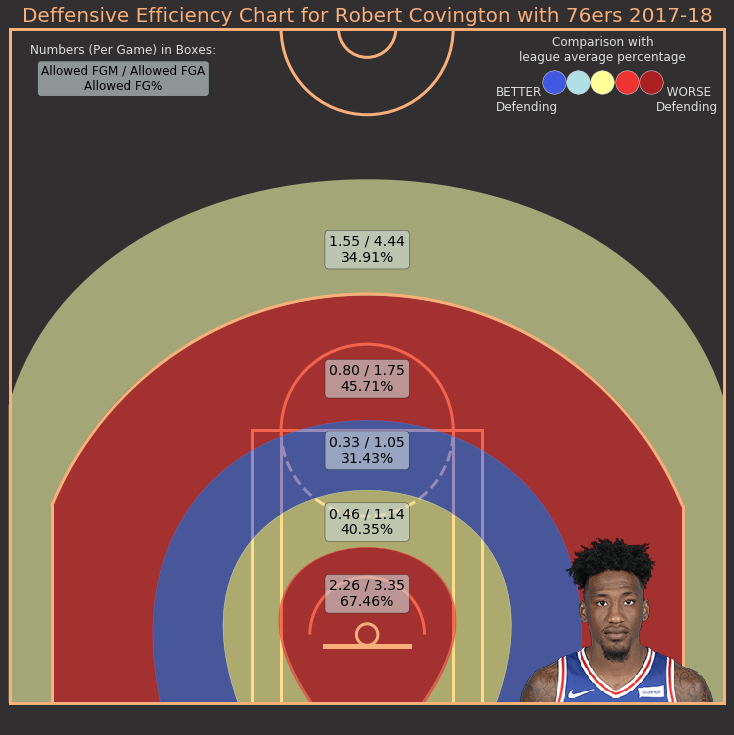
This brings us to the first chart. This is RoCo’s defensive chart, which shows the success of defending the opposing players based on the distance to the basket. He was mostly situated on the 3pt line, defending either three-pointers or long mid-range shots. He was defending the three-pointers quite good, a bit below the average NBA player. But it’s worth mentioning that RoCo led the NBA that season in deflections per game, which shows his relentlessness on the defensive side.
Move to the Timberwolves and injury struggles
But as the pedigree of the Sixers grew, there was, unfortunately, no place for Covington in already Processed Sixers. He was shipped to Minnesota along with Šarić. He struggled in Minnesota, mainly with injuries. He sustained a knee injury and mentioned he was struggling to cope with that as that was the first big injury in his career. However, he managed to successfully jump back into the action this year posting up similar numbers as in the 2017-18 season. Which brings us to this year’s trade deadline.
Change of Style in Houston
As I was always saying, RoCo’s primary position while in 76ers was Small Forward. That kind of already started to shift towards the Power Forward position in Timberwolves. Well with Rockets, Covington plays mostly C/PF position. And he adapted to it gracefully.
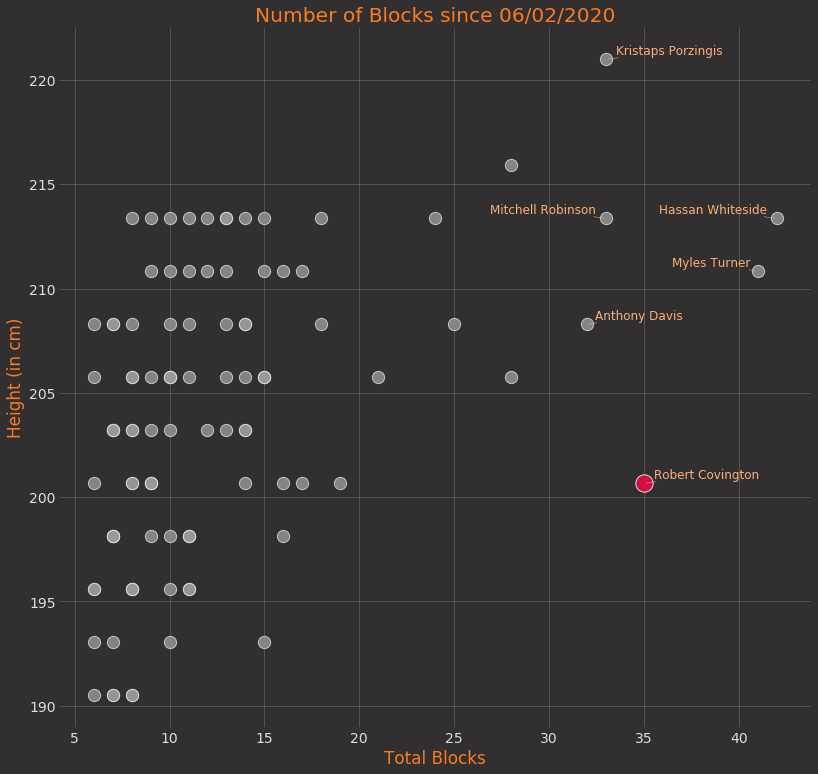
Since the trade to Houston Rockets, he is 3rd in total blocks with 35. He managed to get that number of blocks in 14 games which aren’t a lot of games but that is still a significant sign of change in his position and style.
Focusing on Paint Coverage
Once a top perimeter defender, Covington is now faced with a new role, as he or PJ Tucker are often guarding the centers. Also, they sometimes mix it up with a bit of a zone defense (Box and One, or a 3-2 zone) where again Covington and Tucker stay low. But as mentioned, Rockets most of the time play the usual man-to-man defense with one advantage over (most) other teams. They can switch ANYTHING. All of their guards are taller than average, so quite often Harden ends up in the middle of the paint guarding the opposing center, and the rest of the team swarm the center to put the pressure on.
The result of everything I said is that there is a big difference in the areas where Covington is defending the shots.
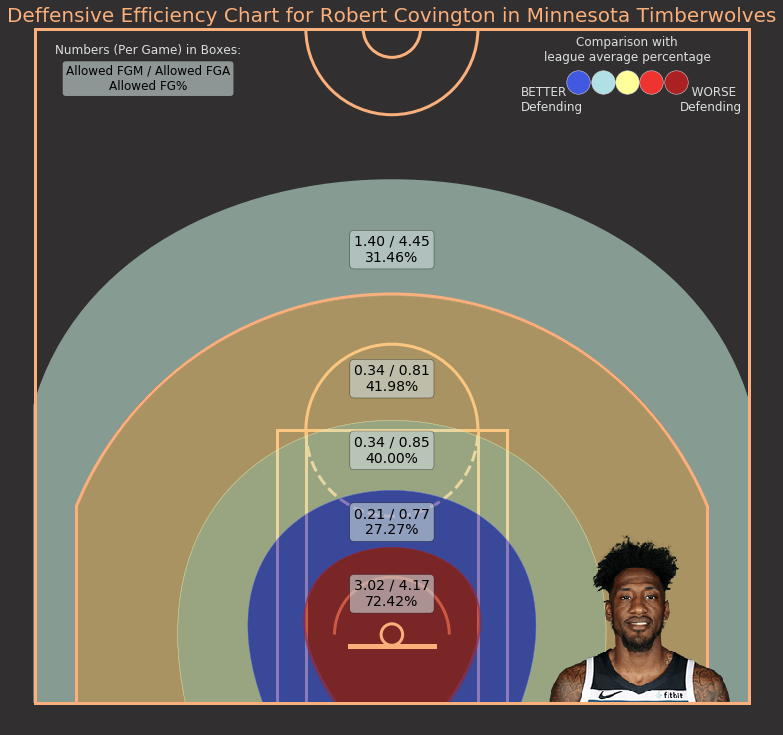
In Minnesota, he spent most of the time on the perimeter, around 3 point line. He was as good defender in Minny as he was during his stint in Philly. However, his interior defense was rather lacking. That could be attributed to the overall bad defense that the Wolves had, but still, it is a pretty bad percentage.
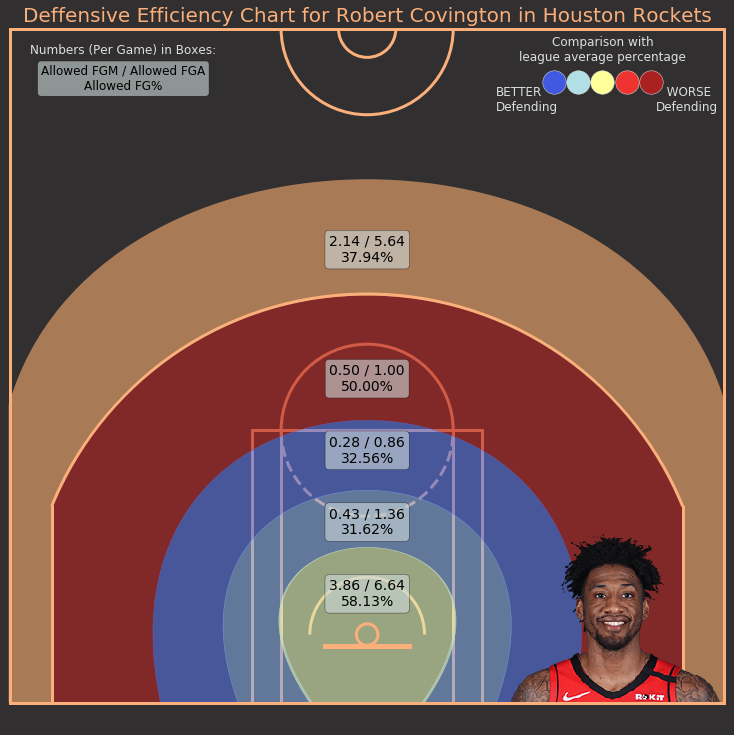
Well, there is a big difference in the Houston chart from the previous one. First of all, look at how much happier Robert is. Secondly, as I already mentioned he spends a lot more time in the post and defending centers, hence the number of defended shots around the basket is a lot higher. The number on the perimeter also increased, which can be attributed to the fact that Rockets switch almost everything so Covington often sticks to the offensive player until he shoots the triple. And while he regressed a bit at that distance, he is still a really good defender. That regression can be maybe tied with the fact than he can sometimes be a bit late to cover the three point shot when he plays on the low post in soft-zones which I mentioned before.
Nevertheless, the really good defensive efficiency close to the basket, for a 6 ft 7 forward, is a huge improvement for him, as well as the Rockets’ team as a whole.
Hustle remains, but in a different way
Covington is known for his high work rate on the defensive side. That usually manifested in a high number of deflections, which would lead to a steal either by him, or his teammate, or it would just generally disrupt the offensive flow.
However, with his move to the Rockets, that changed a bit. His number of deflections took a bit of a hit but remains high, but the positive news is that the number of contested shots, especially 2 point shots, increased significantly.
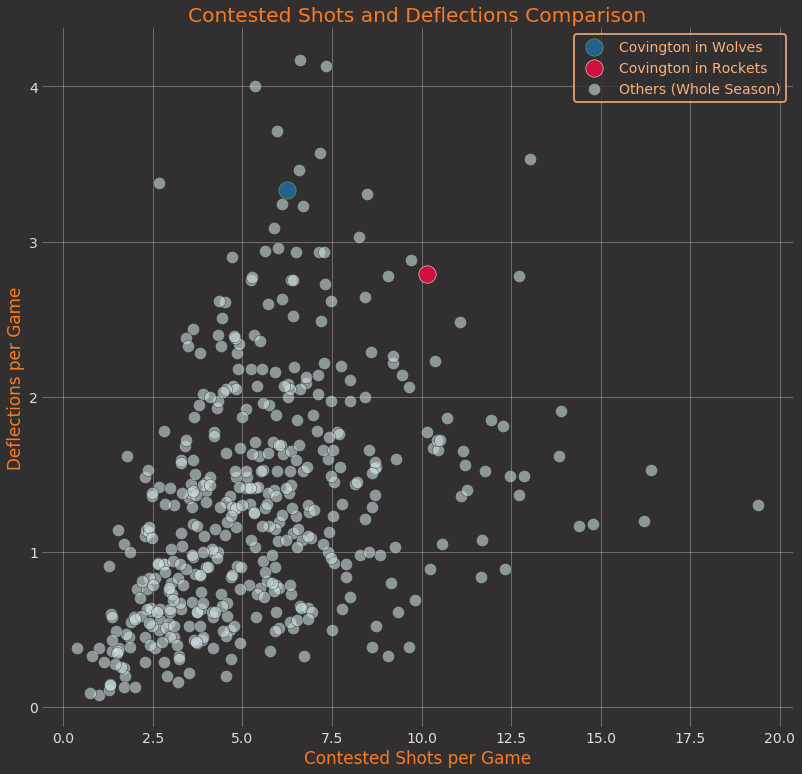
Here you can see how he moved from the middle of the pack in Contested shots, towards the top of the pack.
This amount of contested shots per game, during his 14 game stint with Rockets, is also the highest of his career, by far.
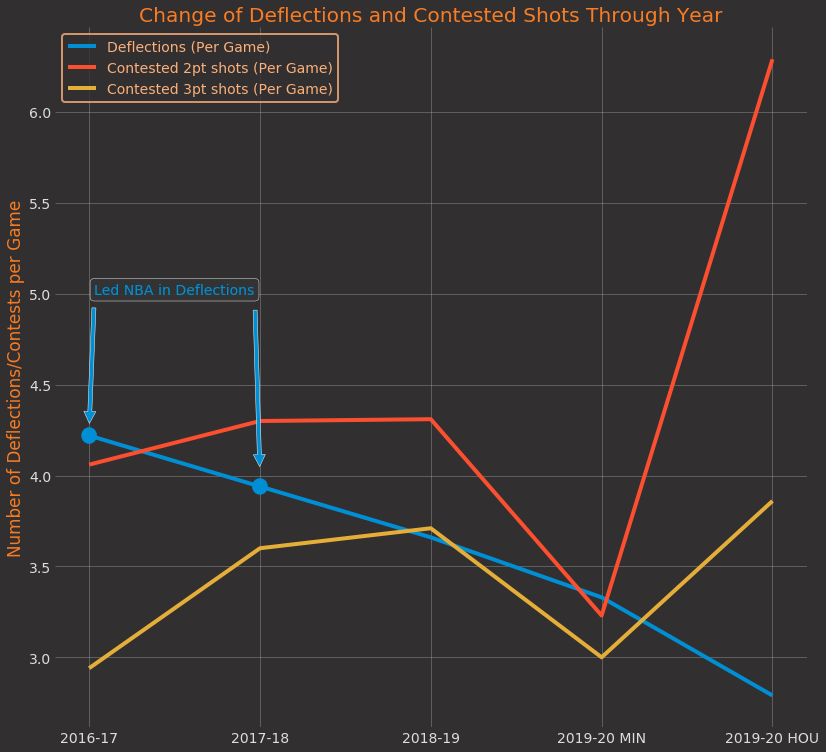
I mentioned in the introduction chapter that Covington led the league in deflections when he was selected for the NBA All-Defensive team. Well, he lead the league season before that as well. His 2018-19 season was shortened by the knee injury, and his number did take a bit of a hit, but they were still pretty elite. Numbers kept decreasing in all categories this season before the trade, after which the number of contested shots skyrocketed.
Impact on the Team
His impact can be seen by looking at the advanced ratings, which calculate the number of points produced per 100 possessions (offensive rating) and points allowed per 100 possessions (defensive rating). While he generally doesn’t add anything special on the offensive side (I’ll touch on that later), he boosts the Rockets significantly on the defensive side.
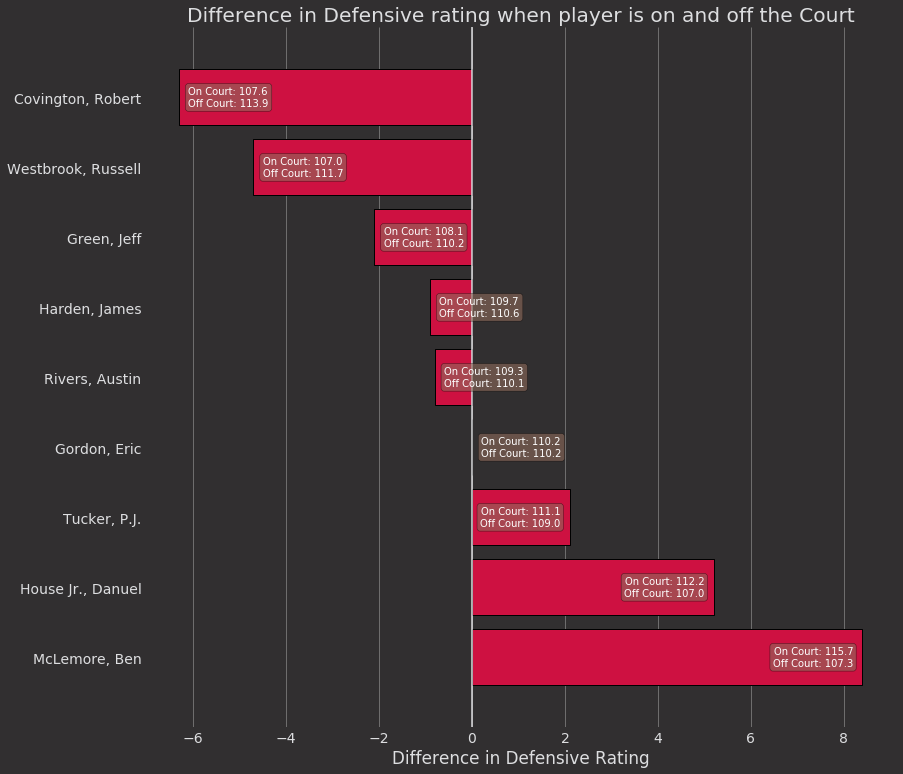
When he is on the court, the Rockets have a better (smaller) defensive rating by 6.3 points per 100 possessions. That is a really big boost. However, as with all other stats and charts I plotted, it’s just on a 14 game sample. But if anything, it’s a positive sign that Rockets pulled of a good trade.
Offensive game
Even though this is mostly a look at Covington’s defensive side of the game, I’ll quickly touch on his offensive adjustment, well actually, he didn’t have to adjust much, as he was already playing in a Moreyball mindset.
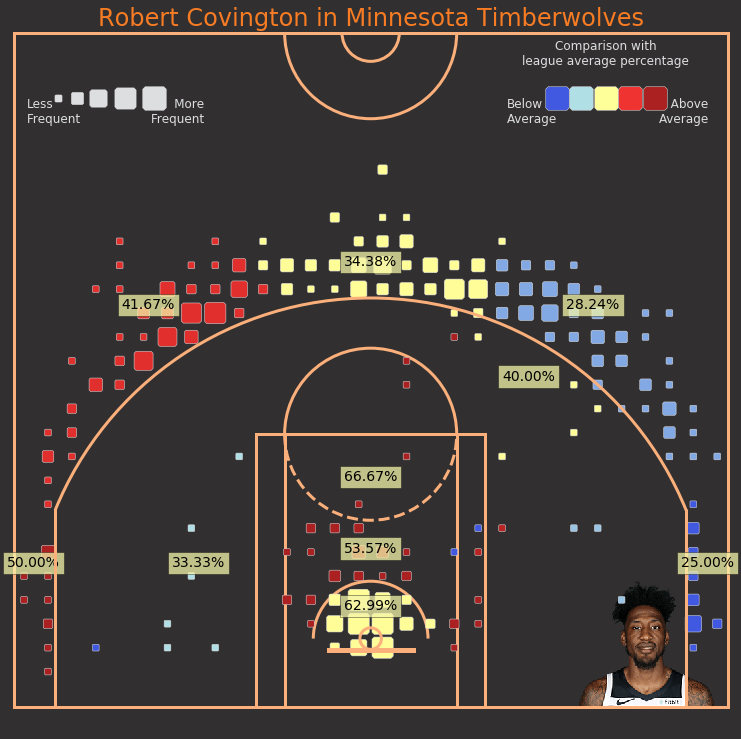
His shot chart from Minnesota did, however, have several mid-range jumpers.
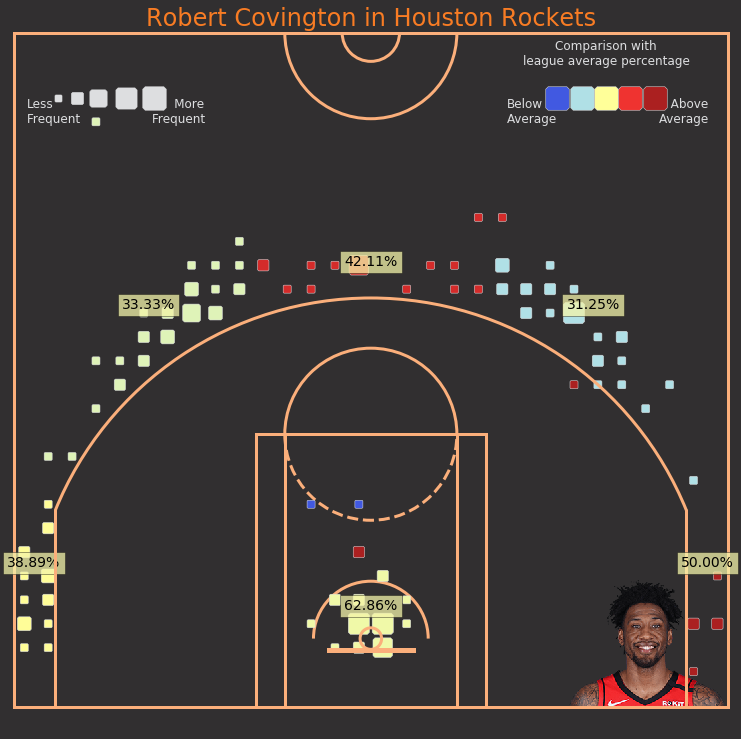
But with the move to Houston, coach D’Antoni and the staff corrected that, now he shoots it only from three-point range or paint. I’m not sure how he allowed himself to shot that single mid-range shot though.
Generally, the volume of three-pointers increased in Houston, he shots 1.5 more three-pointers per game than in Minnesota, with even better efficiency. He was already pretty much a Catch and Shoot type of player as he had 82% of shots assisted in Minny. That number jumped to 94% in Houston. But generally, we can agree that his offensive game fits the Rockets perfectly.
Conclusion
Covington returned to the Rockets’ team almost 6 years after they gave him his first NBA contract. Who knows how his career would have developed had they decided to keep him. He would have fitted in perfectly in Houston’s system all these years. A great wing defender, who is capable of defending big men AND switching onto faster guards. And to complete the package he shoots the three-pointer solidly.
Even if this micro Ball experiment doesn’t turn out great in the end, it is one of the more interesting things to watch develop by the end of the season. And given that the post game is in the slow process of dying, maybe Rockets will turn out to be the crazy and misunderstood geniuses and come out on top?
